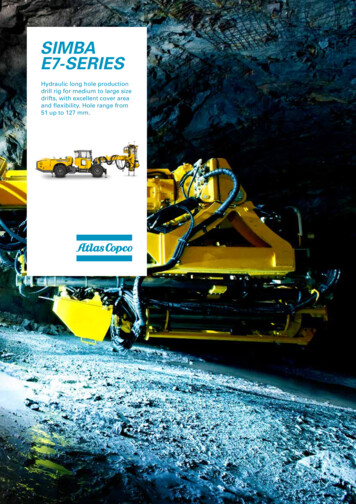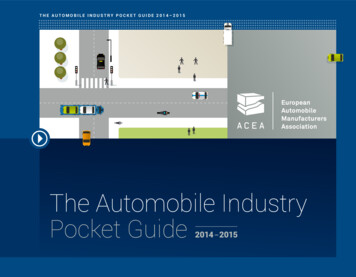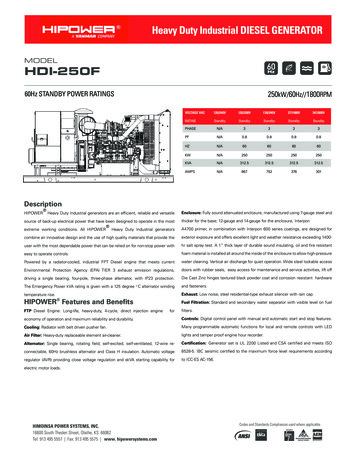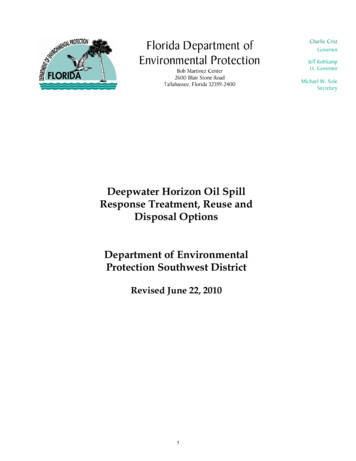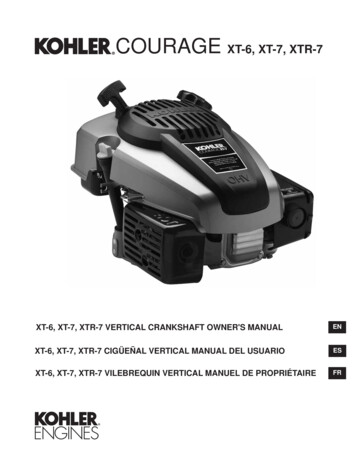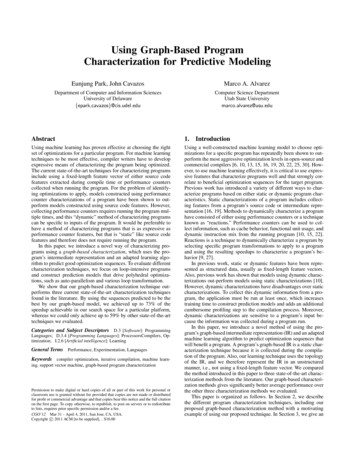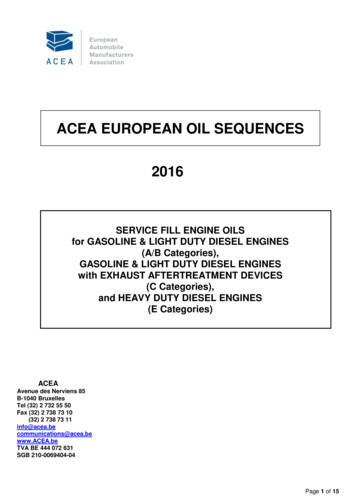
Transcription
ACEA EUROPEAN OIL SEQUENCES2016SERVICE FILL ENGINE OILSfor GASOLINE & LIGHT DUTY DIESEL ENGINES(A/B Categories),GASOLINE & LIGHT DUTY DIESEL ENGINESwith EXHAUST AFTERTREATMENT DEVICES(C Categories),and HEAVY DUTY DIESEL ENGINES(E Categories)ACEAAvenue des Nerviens 85B-1040 BruxellesTel (32) 2 732 55 50Fax (32) 2 738 73 10(32) 2 738 73 11info@acea.becommunications@acea.bewww.ACEA.beTVA BE 444 072 631SGB 210-0069404-04Page 1 of 15
ACEAACEA 2016 EUROPEAN OIL FOR SERVICE-FILL OILSDecember 2016This document details the ACEA 2016 European Oil Sequences for Service-fill Oils for Gasoline engines, for Light DutyDiesel engines, for Gasoline & Diesel engines with after treatment devices and for Heavy Duty Diesel engines. Thesesequences define the minimum quality level of a product for presentation to ACEA members. Individual membercompanies may indicate performance parameters other than those covered by the tests shown or more stringent limits.The ACEA 2016 European Oil Sequences for Service-fill Oils comprise 3 sets (classes) of sequences: one for Gasolineand Light Duty Diesel engines; one specifically for Gasoline and Light Duty Diesel engines with after treatment devicesand one for Heavy Duty Diesel engines. Within each of these sets there are categories which reflect different performancerequirements – three (A3/B3, A3/B4 & A5/B5) for Gasoline and Light Duty Diesel Engines, five (C1, C2, C3, C4, C5)specifically for Engines with After Treatment Devices, and four (E4, E6, E7, E9) for Heavy Duty Diesel Engines. Typicalapplications for each sequence are described below for guidance only. Specific applications of each sequence are theresponsibility of individual engine manufacturers for their own vehicles / engines.The Oil Sequences define the minimum quality level of a product for self-certification to EELQMS and presentation toACEA members. Individual member companies may indicate performance parameters other than those covered by thetests shown or more stringent limits.These Oil Sequences will replace the ACEA 2012 Oil Sequences as a means of defining engine lubricant quality as of 1December 2016.CONDITIONS FOR USE OF PERFORMANCE CLAIMS AGAINST THE ACEA OIL SEQUENCESACEA requires that any claims for Oil performance to meet these Oil Sequences must be based on credible data andcontrolled tests in accredited test laboratories.ACEA requires that engine performance testing used to support a claim of compliance with these ACEA Oil Sequencesshould be generated according to the European Engine Lubricants Quality Management System, EELQMS (available atwww.eelqms.eu), but ACEA reserves the right to define alternatives in exceptional cases.EELQMS addresses product development testing and product performance documentation, and involves the registrationof all candidate and reference oil testing and defines the compliance process. Compliance with the ATIEL Code ofPractice1, which forms part of the EELQMS, is mandatory for any claim to meet the requirements of this issue of the ACEAsequences. Therefore, ACEA requires that claims against the ACEA Oil Sequences can only be made by oil companies oroil distributors who have signed the EELQMS oil marketers’ Letter of Conformance (for details: www.atiel.org).The ACEA Oil Sequences are subject to continuous development. Replacement tests and other changes required by theEuropean vehicle manufacturers are integrated and new issues are published on a regular basis. As new editions arepublished older editions have to be withdrawn. Validities of new and old editions are overlapping for limited periods of timeas shown in the following table and the accompanying text below. When a new ACEA Oil Sequence is introduced, oils withclaims against the previous can be marketed only for another two years.Sequences Issue200420072008201020122016First allowable useMandatory for new claimsOils with this claimmay be marketed until1st November 20041st February 200722nd December 200822nd December 201014th December 20121st December 20161st November 20051st February 200822nd December 200922nd December 201114th December 20131st December 201731st December 200923rd December 201022nd December 201222nd December 20141st December 2018 - First allowable use means that claims cannot be made against the specification before the date indicated.- Mandatory for new claims means that from this date onward all claims for new oil formulations must be madeaccording to the latest ACEA Oil Sequences Issue. Up to that date new claims can also be made according tothe previous ACEA Oil Sequences Issue. After the date indicated no new claims according to the previousACEA Sequence can be made. Then all oil formulations must be developed according to the latest ACEArelease.- Oils with this claim may be marketed until means that no further marketing of oils with claims to this issue isallowed after the date indicated.The marketer of any oil claiming ACEA performance requirements is responsible for all aspects of product liability.1The ATIEL Code of Practice is the sole property of ATIEL and is available from ATIEL (Association Techniquede l’Industrie Européenne des Lubrifiants), Boulevard du Souverain 165, B-1160 Brussels, Belgium.Page 2 of 15
ACEAACEA 2016 EUROPEAN OIL SEQUENCES FOR SERVICE-FILL OILSDecember 2016Where limits are shown relative to a reference oil, then these must be compared to the last valid Reference Result on thattest stand prior to the candidate and using the same hardware. Further details will are in the ATIEL Code of Practice.Where claims are made that oil performance meets the requirements of the ACEA Oil Sequences (e.g. product literature,packaging, labels) they must specify the ACEA Class and Category (see Nomenclature & ACEA Process for definitions).CERTIFICATION and REGISTRATIONClaims against the ACEA Oil Sequences can be made on a self-certification basis. For any Claim being made againstthese ACEA Oil Sequences, ACEA currently recommends Oil Marketers to register their products with the ACEARegistration System on the ACEA website. ACEA will introduce a mandatory registration scheme within 2017 and willinform stakeholders about the procedures to be followed for mandatory registration 3 months in advance of the date ofmandatory registration.All information needed for Registration is available on the ACEA website,see: strations/menu/eor/front-pageEngine Oils claiming any of the ACEA Oil Sequences should be registered directly after their launch into the market. Aftercompleting the form, it will be saved on the ACEA server. If claims are no longer needed oil companies are asked todelete their registration.If claims continue to be used after three years, re-registration is required.NOMENCLATURE & ACEA PROCESS:Each set of Oil Sequences is designated for consumer use by a 2-part code comprising a letter to define the CLASS (e.g.C), and a number to define the CATEGORY (e.g. C1).In addition, for industry use, each sequence has a two-digit number to identify the YEAR of implementation of that severitylevel (e.g. A3/B4-16).The CLASS indicates oil intended for a general type of engines – currently there are:A/B Gasoline and Light Duty Diesel EnginesC Catalyst compatible oils for Gasoline and Light Duty Diesel Engines with Aftertreatment devicesE Heavy Duty Diesel EnginesOther classes may be added in future if, for example, Natural Gas Engines may prove to require oil characteristics whichcannot readily be incorporated into existing classes.The CATEGORY indicates oils for different purposes or applications within that general class, related to some aspect oraspects of the performance level of the oil. Typical applications for each sequence are described below for guidance only.Specific applications of each sequence are the responsibility of the individual motor manufacturer for their own vehiclesand engines. Oils within a category may also meet the requirements of another category but some engines may only besuited to oils of one category within a class.The YEAR numbers for ACEA Sequence is intended only for industry use and indicates the year of implementation of thatseverity level for the particular category. A new year number will indicate, for example, that a new test, parameter or limithas been incorporated in the category to meet new / upgraded performance requirements whilst remaining compatiblewith existing applications. An update must always satisfy the applications of the previous issue. If this is not the case, thena new category is required.An administrative ISSUE Number is added for industry use where it is necessary to update the technical requirements of asequence without the intention to increase severity (e.g. when a CEC test engine is updated to the latest version whilstmaintaining equivalent severity; or where a severity shift in the test requires modification of the specified limits.).Where claims are made that Oil Performance meets the requirements of the ACEA Oil Sequences (e.g. product literature,packaging, labels) they must specify the ACEA Class and Category (see Nomenclature & ACEA Process for definitions).Page 3 of 15
ACEAACEA 2016 EUROPEAN OIL SEQUENCES FOR SERVICE-FILL OILSDecember 2016«Consumer Language»:A/B: Gasoline and Diesel Engine Oils – “High SAPS”A1/B1 Category is removed with these Oil Sequences.A3/B3 Stable, stay-in-grade Engine Oil intended for use in Passenger Car & Light Duty Van Gasoline & Diesel Engineswith extended drain intervals where specified by the Engine Manufacturer, and for severe operating conditions asdefined by the Engine Manufacturer.A3/B4 Stable, stay-in-grade Engine Oil intended for use at extended Drain Intervals in Passenger Car & Light Duty VanGasoline & DI Diesel Engines, but also suitable for applications described under A3/B3.A5/B5 Stable, stay-in-grade Engine Oil intended for use at extended Drain Intervals in Passenger Car & Light Duty VanGasoline & Diesel Engines designed to be capable of using Low Viscosity Oils with HTHS Viscosity of 2.9 to 3.5mPa s. These Oils are unsuitable for use in certain Engines - consult vehicle-OEM’s owner’s manual/handbook incase of doubt.C: Catalyst & GPF/DPF compatible Engine Oils for Gasoline & Diesel Engines – “Low SAPS”Note:Warning:These Oils will increase the DPF/GPF and TWC life and maintain the Vehicle’s Fuel Economy.Some of these Categories may be unsuitable for use in certain Engine Types – consult the vehicleOEM’s owner’s manual/handbook in case of doubt.C1Stable, stay-in-grade Engine Oil with Lowest SAPS-Level, intended for use as catalyst compatible Oil at extendedDrain Intervals in Vehicles with all Types of modern Aftertreatment Systems and High Performance PassengerCar & Light Duty Van Gasoline & DI Diesel Engines that are designed to be capable of using Low Viscosity Oilswith a minimum HTHS Viscosity of 2.9 mPa s.C2Stable, stay-in-grade Engine Oil with Mid SAPS-Level, intended for use as catalyst compatible Oil at extendedDrain Intervals in Vehicles with all Types of modern Aftertreatment Systems and High Performance PassengerCar & Light Duty Van Gasoline & DI Diesel Engines that are designed to be capable of using Low Viscosity Oilswith a minimum HTHS Viscosity of 2.9 mPa s.C3Stable, stay-in-grade Engine Oil with Mid SAPS-Level, intended for use as catalyst compatible Oil at extendedDrain Intervals in Vehicles with all Types of modern Aftertreatment Systems and High Performance PassengerCar & Light Duty Van Gasoline & DI Diesel Engines that are designed to be capable of using Oils with a minimumHTHS Viscosity of 3.5 mPa s.C4Stable, stay-in-grade Engine Oil with Low SAPS-Level, intended for use as catalyst compatible Oil at extendedDrain Intervals in Vehicles with all Types of modern Aftertreatment Systems and High Performance PassengerCar & Light Duty Van Gasoline & DI Diesel Engines that are designed to be capable of using Oils with a minimumHTHS Viscosity of 3.5 mPa s.C5Stable, stay-in-grade Engine Oil with Mid SAPS-Level, for further improved Fuel Economy, intended for use ascatalyst compatible Oil at extended Drain Intervals in Vehicles with all Types of modern Aftertreatment Systemsand High Performance Passenger Car & Light Duty Van Gasoline & DI Diesel Engines that are designed to becapable and OEM-approved for use of Low Viscosity Oils with a minimum HTHS Viscosity of 2.6 mPa s.SAPS:HTHS:DI:DPF:GPF:TWC:Sulphated Ash, Phosphorus, SulphurHigh Temperature High Shear ViscosityDirect InjectionDiesel Particle FilterGasoline Particle FilterThree-Way CatalystPage 4 of 15
ACEAACEA 2016 EUROPEAN OIL SEQUENCES FOR SERVICE-FILL OILSDecember 2016E: Heavy Duty Diesel Engine OilsE4Stable, stay-in-grade oil providing excellent control of piston cleanliness, wear, soot handling and lubricantstability. It is recommended for highly rated diesel engines meeting Euro I, Euro II, Euro III, Euro IV and Euro Vemission requirements and running under very severe conditions, e.g. significantly extended oil drain intervalsaccording to the manufacturer’s recommendations. It is suitable for engines without particulate filters, and forsome EGR engines and some engines fitted with SCR NOx reduction systems. However, recommendations maydiffer between engine manufacturers so driver manuals and/or dealers shall be consulted if in doubt.E6Stable, stay-in-grade oil providing excellent control of piston cleanliness, wear, soot handling and lubricantstability. It is recommended for highly rated diesel engines meeting Euro I, Euro II, Euro III, Euro IV, Euro V andEuro VI emission requirements and running under very severe conditions, e.g. significantly extended oil drainintervals according to the manufacturer’s recommendations. It is suitable for EGR engines, with or withoutparticulate filters, and for engines fitted with SCR NOx reduction systems. E6 quality is strongly recommended forengines fitted with particulate filters and is designed for use in combination with low sulphur diesel fuel. However,recommendations may differ between engine manufacturers so driver manuals and/or dealers shall be consultedif in doubt.E7Stable, stay-in-grade oil providing effective control with respect to piston cleanliness and bore polishing. It furtherprovides excellent wear control, soot handling and lubricant stability. It is recommended for highly rated dieselengines meeting Euro I, Euro II, Euro III, Euro IV and Euro V emission requirements and running under severeconditions, e.g. extended oil drain intervals according to the manufacturer’s recommendations. It is suitable forengines without particulate filters, and for most EGR engines and most engines fitted with SCR NOx reductionsystems. However, recommendations may differ between engine manufacturers so driver manuals and/or dealersshall be consulted if in doubt.E9Stable, stay-in-grade oil providing effective control with respect to piston cleanliness and bore polishing. It furtherprovides excellent wear control, soot handling and lubricant stability. It is recommended for highly rated dieselengines meeting Euro I, Euro II, Euro III, Euro IV, Euro V and Euro VI emission requirements and running undersevere conditions, e.g. extended oil drain intervals according to the manufacturer’s recommendations. It is suitablefor engines with or without particulate filters, and for most EGR engines and for most engines fitted with SCR NOxreduction systems. E9 is strongly recommended for engines fitted with particulate filters and is designed for use incombination with low Sulphur diesel fuel. However, recommendations may differ between engine manufacturersso driver manuals and/or dealers should be consulted if in doubtPage 5 of 15
ACEAACEA 2016 EUROPEAN OIL SEQUENCE FOR SERVICE-FILL OILS FORGASOLINE and DIESEL ENGINESDecember 2016This sequence defines the minimum quality level of a product for self-certification to EELQMS and for presentation to ACEA members.Individual member companies may indicate performance parameters other than those covered by the tests shown or more stringent limits.REQUIREMENTTEST 1. LABORATORY TESTS1.1Viscosity Class according toViscositySAE J300 - Latest active issueNo restriction except as defined by HTHS and Shear Stabilityrequirements. Manufacturers may indicate specific Viscosityrequirements related to ambient temperature.Grades1.2 *ShearStability1.3.1CEC L-014-93orASTM D6278orASTM D7109Kinematic Viscosity at 100 CCEC L-036-90Dynamic Viscosity at 150 C1.3.2 *after 30 cyclesand Shear Rate ofHTHS ViscosityCEC L-036-90All grades to be “stay in grade”mm2/s106mPa s 3.5 2.9 & 3.5mPa s--Reports-1Dynamic Viscosity at 100 Cand Shear Rate of 106 s-1HTHS Viscosityat 100 C1.4EvaporativeCEC L-040-93(Noack)Max. weight lossafter 1 h at 250 C% 13Loss1.5 8.0 10.0ASTM D 2896mgKOH/gASTM D5185% m/mReportASTM D5185% m/mReportASTM D874% m/m 8.0TBN1.6 *Sulphur1.7 *Phosphorus1.8 * 0.9 and 1.5 1.0 and 1.6 1.6Sulphated Ash1.9ppm m/mASTM D6443ReportChlorine1.10 *CEC L-112-16ElastomerCompatibility- Tensile Strength- Elongation at Rupture- Volume Variation1.11FoamingRE6RE7RE8RE9Max. Variation of Characteristicsafter immersion for 7 daysin Fresh Oil without Pre-Ageing:Oil - ElastomerASTM D892%ReportReportReportReport%-70/ 20-65/ 15-51/ 9-65/ 19%-5.5/ 2.1-1.8/ 8.90.0/ 12.0-2.5/ 16.0Tendency - stabilitymlSequence I (24 C) 10 – nilSequence II (94 C) 50 - nilSequence III (24 C) 10 - nilTendency - stabilitymlSequence IV (150 C) 100 – nilwithout option ATendency1.12HighTemperatureASTM D6082HighTemperaturefoam testFoamingTendencyPage 6 of 15
ACEAACEA 2016 EUROPEAN OIL SEQUENCE FOR SERVICE-FILL OILS FORGASOLINE and DIESEL ENGINESDecember 2016This sequence defines the minimum quality level of a product for self-certification to EELQMS and for presentation to ACEA members.Individual member companies may indicate performance parameters other than those covered by the tests shown or more stringent limits.REQUIREMENTTEST 1. LABORATORY TESTS CONTINUED1.13CEC L-105-12LowYield stress(MRV at SAE J300 Temperatures,applicable for the Fresh Oil ViscosityGrade)TemperaturePumpability1.14MRVCEC L-109-16Oil Oxidation at 168hmPa sAccording to SAE J300 for Fresh OilPaA/cm 120 120 100ReportReport 120 150 150 60ReportReport 150(DIN 51453)Oil Oxidationwith BiodieselOil Oxidation at 216h (EOT)A/cm(DIN 51453)for Engine Oilsoperatingin the presenceViscosity Increase, relative at 168hof Biodiesel Fuel(Delta KV100)%Viscosity Increase, relative at 216h%(Delta KV100 at EOT 216h)Page 7 of 15
ACEAACEA 2016 EUROPEAN OIL SEQUENCE FOR SERVICE-FILL OILS FORGASOLINE and DIESEL ENGINESDecember 2016This sequence defines the minimum quality level of a product for self-certification to EELQMS and for presentation to ACEA members.Individual member companies may indicate performance parameters other than those covered by the tests shown or more stringent limits.REQUIREMENTTEST 2. ENGINE TESTS2.1Gasoline DICEC L-111-16Piston CleanlinessMerit RL259Turbo Charger Deposits **,average value of zones C, D, E & FMerit 6.0(EP6CDT)EngineCleanliness2.2 *ASTM D6593-00Average engine sludgeMerit 7.8Low(Sequence VG)Rocker cover sludgeMerit 8.0TemperatureUnder protocolAverage Piston skirt varnishMerit 7.5Sludge& requirementsAverage engine varnishMerit 8.9for APIComp. ring (hot stuck)noneOil screen clogging%Daimler M271Engine Sludge, AverageMeritCEC L-054-96Fuel Economy Improvement%Absolute Viscosity Increaseat 100 C and 5.5 % Sootmm2/s 202.3 *Valve TrainScuffing Wear2.4 * RL140 4 Black Sludge2.5 *Fuel Economy2.6DI Diesel 2.5---(M111)CEC L-106-16(DV6C)Oil DispersionPiston Cleanliness ** 0.9 x RL248 2.5Meritat MediumTemperature2.7Diesel EngineWearCEC L–099-08Cam wear outlet (avg. max. wear 8 cams) m 140 120(OM646LA)Cam wear inlet (avg. max. wear 8 cams) ** m 110 100Cylinder wear (avg. 4 cylinders) ** m 5.0 5.0Bore polishing (13 mm) **(max. value of 4 cylinders)% 3.5 3.0Tappet wear inlet ** mReportReport mReportReportMeritReport 12MeritReport 8,8(avg. max. wear 8 cams)Tappet wear outlet **(avg. max. wear 8 cams)Piston cleanliness (avg. 4 pistons) **Engine sludge average **Page 8 of 15
ACEAACEA 2016 EUROPEAN OIL SEQUENCE FOR SERVICE-FILL OILS FORGASOLINE and DIESEL ENGINESDecember 2016This sequence defines the minimum quality level of a product for self-certification to EELQMS and for presentation to ACEA members.Individual member companies may indicate performance parameters other than those covered by the tests shown or more stringent limits.REQUIREMENTTEST Merit RL206minus4 points RL206 RL206ASF 1.2 1.0 1.0ringASF 2.5 1.0 1.0Max. for any 2nd ringASF0.00.00.0EOT TBN (ISO 3771) **mgKOH/g 4.0 6.0 4.0EOT TAN (ASTM D664) **mgKOH/gReportReportReport2. ENGINE TESTS CONTINUED2.8 *DI DieselCEC L-078-99Piston Cleanliness(VW TDI)PistonRing sticking (Rings 1 & 2)Cleanliness &Average of all 8 ringsRing StickingMax. for any1st2.9CEC L-104-16Piston CleanlinessMerit RL255 2Effects of(OM646LA Bio)Ring Sticking **ASFReportSludge **MeritReportBiodiesel*/**: Footnote information see last page of the C-Categories.Page 9 of 15
ACEAACEA 2016 EUROPEAN OIL SEQUENCE FOR SERVICE-FILL OILS FORGASOLINE and DIESEL ENGINES WITH AFTERTREATMENT DEVICESDecember 2016This sequence defines the minimum quality level of a product for self-certification to EELQMS and for presentation to ACEA members.Individual member companies may indicate performance parameters other than those covered by the tests shown or more stringent limits.REQUIREMENTTEST 61. LABORATORY TESTSViscosity Class according to1.1Viscosity GradesCEC L-014-93orASTM D6278orASTM D7109Kinematic Viscosity at 100 C1.3.1HTHS ViscosityCEC L-036-90Dynamic Viscosity at 150 C1.3.2 *HTHS Viscosityat 100 C1.4CEC L-036-90Evaporative loss(Noack)1.2*Shear Stability1.5No restriction except as defined by HTHS and Shear Stabilityrequirements. Manufacturers may indicate specific Viscosityrequirements related to ambient temperature.SAE J300 - Latest active issueAll grades to be “stay in grade”mm2/safter 30 cyclesmPa s 2.9 3.5 2.6 & 2.9mPa sReportReportReportand Shear Rate of 106 s-1Dynamic Viscosity at 100 Cand Shear Rate of 106 s-1CEC L-040-93Max. weight loss 13% 11 13 6.0 6.0 0.2 0.3after 1 h at 250 CASTM D2896mgKOH/gASTM D5185% m/mASTM D5185% m/m 6.0---TBN1.6 * 0.2 0.3Sulphur1.7 * 0.05Phosphorus1.8 *ASTM D874% m/mASTM D6443ppm m/m 0.5 0.07 0.07 0.09 0.09 0.07 0.8 0.09 0.09 0.5 0.8Sulphated Ash1.9ReportChlorine1.10 *CEC L-112-16ElastomerCompatibility- Tensile Strength- Elongation at Rupture- Volume ReportMax. Variation of Characteristicsafter immersion for 7 daysin Fresh Oil without Pre-Ageing:Oil - ElastomerASTM D892%%-70/ 20-65/ 15-51/ 9-65/ 19%-5.5/ 2.1-1.8/ 8.90.0/ 12.0-2.5/ 16.0Tendency - stabilitymlSequence I (24 C) 10 - nilSequence II (94 C) 50 - nilSequence III (24 C) 10 - nilTendency - stabilitymlSequence IV (150 C) 100 – nilwithout option ATendency1.12HighTemperatureFoamingTendencyASTM D6082High TemperatureFoam TestPage 10 of 15
ACEAACEA 2016 EUROPEAN OIL SEQUENCE FOR SERVICE-FILL OILS FORGASOLINE and DIESEL ENGINES WITH AFTERTREATMENT DEVICESDecember 2016This sequence defines the minimum quality level of a product for self-certification to EELQMS and for presentation to ACEA members.Individual member companies may indicate performance parameters other than those covered by the tests shown or more stringent limits.REQUIREMENTTEST 61. LABORATORY TESTS CONTINUED1.13CEC L-105-12LowYield stress(MRV at SAE J300 Temperatures,applicable for the Fresh Oil ViscosityGrade)TemperaturePumpability1.14MRVCEC L-109-16Oil Oxidation at 168 hmPa sAccording to SAE J300 for Fresh OilPaA/cm 100 100 100 100 100A/cm 120 120 120 120 120% 60 60 60 60 60% 150 150 150 150 150(DIN 51453)Oil Oxidationwith BiodieselOil Oxidation at 216 h (EOT)(DIN 51453)for Engine Oilsoperatingin the presenceViscosity Increase, relative at 168 hof Biodiesel Fuel(Delta KV100)Viscosity Increase, relative at 216 h(Delta KV100 at EOT 216 h)Page 11 of 15
ACEAACEA 2016 EUROPEAN OIL SEQUENCE FOR SERVICE-FILL OILS FORGASOLINE and DIESEL ENGINES WITH AFTERTREATMENT DEVICESDecember 2016This sequence defines the minimum quality level of a product for self-certification to EELQMS and for presentation to ACEA members.Individual member companies may indicate performance parameters other than those covered by the tests shown or more stringent limits.REQUIREMENTTEST 62. ENGINE TESTS2.1Gasoline DICEC L-111-16EngineCleanliness2.2 *LowTemperatureSludgePiston CleanlinessMerit RL259Turbo Charger Deposits **,average value of zones C, D, E & FMerit 6.0Average engine sludgeMerit 7.8Rocker cover sludgeMerit 8.0Average Piston skirt varnishMerit 7.5Average engine varnishMerit 8.9(EP6CDT)ASTM D6593-00(Sequence VG)Under protocol& requirementsfor APIComp. ring (hot stuck)noneOil screen clogging%Daimler M271Engine Sludge, AverageMerit2.5 *CEC L-054-96Fuel Economy Improvement%Fuel(M111)Absolute Viscosity Increaseat 100 C and 5.5 % Sootmm2/s 202.3 *Valve TrainScuffingWear2.4 * RL140 4 Black Sludge 3.0 2.5 1.0(for xW-30 only,no limit for xW-40) 3.0Economy2.6DI DieselCEC L-106-16(DV6C)Oil 0.9 x RL248 2.5MeritPiston Cleanliness **Dispersion atMediumTemperature2.7Diesel EngineWearCEC L-099-08Cam wear outlet (avg. max. wear 8 cams) m 120 120 120 120(OM646LA)Cam wear inlet (avg. max. wear 8 cams) ** m 100 100 100 100Cylinder wear (avg. 4 cylinders) ** m 5.0 5.0 5.0 5.0Bore polishing (13 mm) **(max. value of 4 cylinders)% 3.0 3.0 3.0 3.0 mReportReportReportReport mReportReportReportReportMeritReportReport 12 12MeritReportReport 8,8 8,8Tappet wear inlet **(avg. max. wear 8 cams)Tappet wear outlet **(avg. max. wear 8 cams)Piston cleanliness(avg. 4 pistons)Engine sludge average ****Page 12 of 15
ACEAACEA 2016 EUROPEAN OIL SEQUENCE FOR SERVICE-FILL OILS FORGASOLINE and DIESEL ENGINES WITH AFTERTREATMENT DEVICESDecember 2016This sequence defines the minimum quality level of a product for self-certification to EELQMS and for presentation to ACEA members.Individual member companies may indicate performance parameters other than those covered by the tests shown or more stringent limits.REQUIREMENTTEST 6Merit RL206 RL206 RL206 RL206Average of all 8 ringsASF 1.0 1.2 1.0 1.0Cleanliness &Max. for any 1st ringASF 1.0 2.5 1.0 1.0Ring StickingMax. for any 2nd ringASF0.00.00.00.02. ENGINE TESTS CONTINUED2.8 *CEC L-078-99(VW TDI)DI DieselPiston cleanlinessRing sticking (Rings 1 & 2)PistonEOT TBN (ISO 3771) **mgKOH/gReportReportReportReportEOT TAN (ASTM D 664) **mgKOH/gReportReportReportReport2.9CEC L-104-16Piston CleanlinessMerit RL255 2Effects of(OM646LA Bio)Ring Sticking **ASFReportSludge **MeritReportBiodiesel*/**: Footnotes referring to the following Requirements in the A-/B- and C-Classes:No. 1.2Referring to the latest Version of the SAE J300 the minimum Viscosity for xW-20 Oils after Shearing is 6.9 cStNo. 1.3.2The CEC-L036-90 method is not yet approved for the parameter HTHS at 100 C.No. 1.6, 1.7, 1.8Maximum limits, Values take into account method and production tolerancesNo. 1.6, 1.7Internal standard method must be used.No. 1.10For Categories A3/B3, A3/B4, A5/B5 and C1, C2, C3, C4: Available Test data from the Predecessor-Test CEC L-039-96 maybe used for ACEA 2016 instead of CEC L-112-16 under the condition that a Full L-039 Data set including RE1, RE2, RE3 &RE4 the Daimler DBL-AEM (requirements as specified by Daimler AG), provided the requirements as specified in ACEA2012 are met.No. 2.1, 2.6 2.9** Parameter is not an official CEC ParameterNo. 2.2The limits shown are based on those applied in U.S. market requirements. ACEA will continuously review the situation toensure that these limits are appropriate for European vehicles and lubricants.Once the successor Test Seq. VH, which is currently still under development, is fully ASTM approved, the Seq. VH may berun with Limits officially communicated by ACEA.No. 2.3The CEC L-038-94 (TU3M) Test was removed from these Oil Sequences since hardware will run out in early 2017. However,in order to assure/support Wear Protection although TU3 is removed, ACEA intends to introduce the ASTM Seq. IVB Test asa TU3-Sucessor regarding valve train wear with the next Oil Sequences Revision, with Limits for Seq. IVB then to be definedbased on ILSAC Spec.No. 2.4Until the new CEC Test Method L-107 is fully developed, the Gasoline Sludge Protection Performance of Engine OilFormulations must be proven by the M271 Sludge Test procedure as described by Daimler AG. Test results obtained by theM271 procedure will be accepted only under the condition that they come from Test Rigs being referenced and qualitycontrolled by Daimler AG. Limits are based on the same Reference Oil as with the old M111 Sludge Test.Once the L-107 Procedure is fully CEC-approved, the L-107 may be used, with limits officially communicated by ACEA.No. 2.8* Test Report must give measured values before & after the test, all measurements to be taken in the same lab.Note: EOT TAN is considered to become performance criteria in the future. Any test run prior to the publicationof the ACEA 2012 Oil Sequences can be used whether or not it has data for EOT TAN.Page 13 of 15
ACEAACEA 2016 EUROPEAN OIL SEQUENCE FOR SERVICE-FILL OILSFOR HEAVY DUTY DIESEL ENGINESDecember 2016This sequence defines the minimum quality level of a product for self-certification to EELQMS and for presentation to ACEA members.Individual member companies may i
Page 4 of 15 ACEA ACEA 2016 EUROPEAN OIL SEQUENCES FOR SERVICE-FILL OILS December 2016 «Consumer Language»: A/B: Gasoline and Diesel Engine Oils - "High SAPS" A1/B1 Category is removed with these Oil Sequences. A3/B3 Stable, stay-in-grade Engine Oil intended for use in Passenger Car & Light Duty Van Gasoline & Diesel Engines with extended drain intervals where specified by the Engine .



